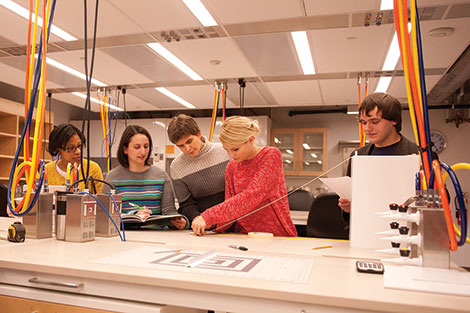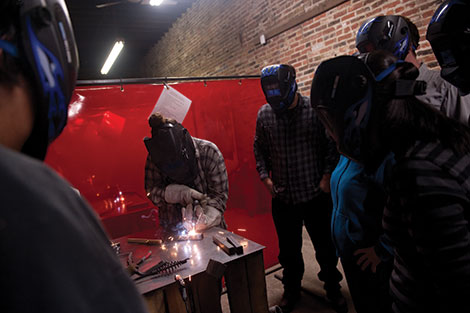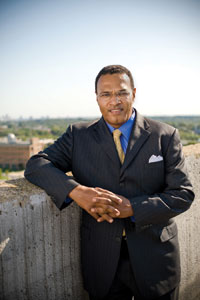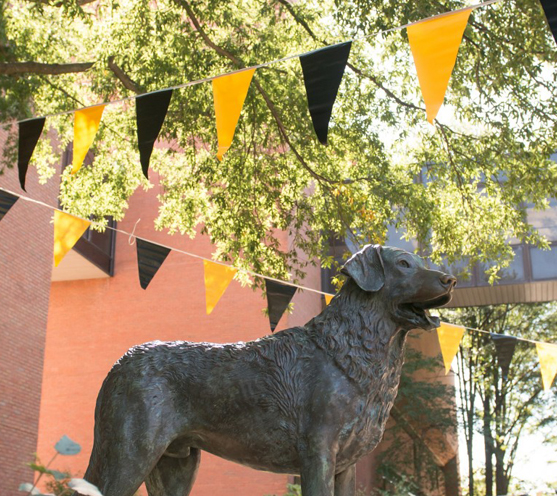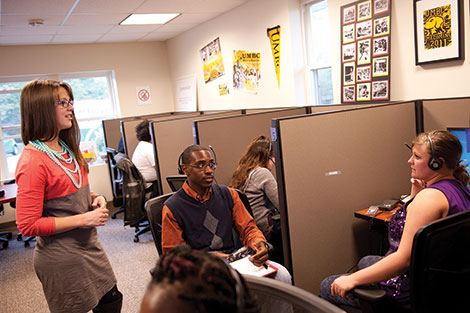UMBC alumni, professors and students find new spaces and places for innovation.
Photography by Marlayna Demond ’11
* * * *
Much of the journey of creation takes place in the space of the human mind. Yet that journey is not a solitary one. Intellects require companionship. Great ideas spark new approaches – and more new ideas – when they are tested by conversation and forged in collaboration. And those combinations require spaces to encourage and enhance their work.
A research university such as UMBC excels in creating such spaces. Not only do its professors and students create them on (or nearby) the campus, but the university’s alumni carry that spirit of exploration into our community.
We invite you to take a closer looks at these spaces where the next great ideas in numerous disciplines are being developed or taught right now by members of the UMBC community.
BETAMORE
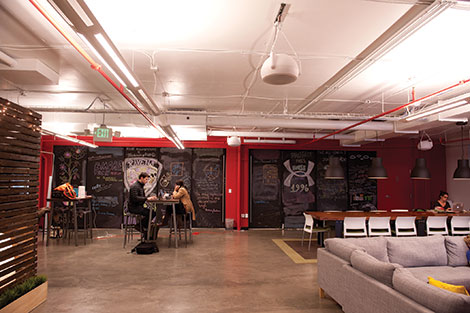 Reminders of the urgency of connecting are everywhere at Betamore – a business incubator occupying nearly 8,000 square feet on the top floor of a four-story building in Federal Hill with a view of South Baltimore that could get anyone’s creative juices flowing.
Reminders of the urgency of connecting are everywhere at Betamore – a business incubator occupying nearly 8,000 square feet on the top floor of a four-story building in Federal Hill with a view of South Baltimore that could get anyone’s creative juices flowing.
A screen-printed poster in the front room puts it bluntly: “Stop Tweeting Boring Shit.”
Co-founded by Greg Cangialosi ’96, English in January 2013, Betamore offers entrepreneurs who pay a monthly membership fee the chance to share everything from a beer-stocked fridge or an internet connection to nooks and crannies in which to take refuge and large couches for the occasional power nap.
Startups in fields including healthcare, education, software development and cybersecurity currently share the space. Yet what these entrepreneurs discover is that knowledge is the most important thing shared at Betamore through a regular lineup of guest speakers, classes, happy hours, and old fashioned mentoring from Cangialosi and his fellow co-founders Mike Brenner and Sean Lane.
Part of Betamore’s attraction for its resident companies is that variety and unpredictability. “It’s the mystique of not knowing who’s around you,” quips Cangialosi.
Brenner concurs: “By programming the space and bringing in different minds, there’s bound to be a really interesting outcome.”
After graduating from UMBC, Cangialosi started Blue Sky Factory – a successful email marketing company that he sold in 2011 to pursue Betamore and a number of other projects. (Cangialosi is also the managing director of Baltimore Angels, a group that nurtures and invests in local entrepreneurs.)
The space itself is only one element of the Betamore complex. Its founders also created an “Academy” – which features open, fee-based classes for those who want to learn technology and business skills (such as web development or digital marketing sales) from those already succeeding in business. The Federal Hill site also provides a headquarters for Betamore Works – a matchmaking venture that hooks up Betamore graduates with potential employers.
Betamore’s flexible design reflects the way creative people tend to work. While the site itself is a key part of Betamore, Cangialosi says that the venture’s potential to create new collaborations and innovations in Baltimore are even more important than the space itself.
“We love the space, and we love Federal Hill,” says Cangialosi. “The density of its ‘live, work, play’ environment – and its potential to become a serious tech hub in Baltimore – is what we really love about it.”
– Sarah Truckey
Find out more about Betamore at: http://www.betamore.com/
IMDA STUDIOS
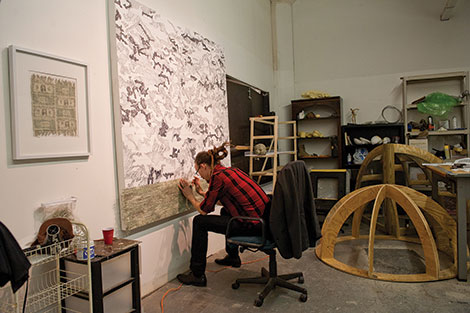 Each year, Imaging and Digital Arts (IMDA) students at UMBC nearing completion of their Master of Fine Arts degrees present their work in an exhibition at the Center for Arts, Design and Visual Culture (CADVC), bringing a wide range of visually stunning and socially conscious multimedia installation, photography, sculpture and design to the campus community. Yet much of the work displayed each year at the CADVC is created and shaped in the program’s off-campus studios in nearby Pigtown.
Each year, Imaging and Digital Arts (IMDA) students at UMBC nearing completion of their Master of Fine Arts degrees present their work in an exhibition at the Center for Arts, Design and Visual Culture (CADVC), bringing a wide range of visually stunning and socially conscious multimedia installation, photography, sculpture and design to the campus community. Yet much of the work displayed each year at the CADVC is created and shaped in the program’s off-campus studios in nearby Pigtown.
When the IMDA Studios were founded 13 years ago, the only on-campus spaces available for graduate students to pursue their work were scattered across multiple buildings, So Jon Sturgeon (chair of visual arts in 2001) and Vin Grabill (present chair and the director of the IMDA program at the time) sought an off-campus site to provide unified studio space for graduate students.
They settled on a space in the Raleigh Industrial Center. Stephen Bradley, director of the IMDA program, says that “the purpose of the Raleigh studios was to offer students a unique fabrication space where they could experiment with installation, performance and other hybrid artistic forms that required larger open raw space.”
Experimentation is a key concept behind the 4,800 square foot space, which has an open floor plan that allows for customizable individual studios. Students drape, shift, and even remove the false walls that compose their spaces, or install televisions and projectors and mount shelves and speakers as their projects develop and transform.
Indeed, Bradley sees the space as a laboratory of sorts. “Artists work like chemists in a lot of ways,” he observes. “They’re bringing things together, creating hybrid works, mixing metaphors.”
For Jason Hughes ’15, the studio is where he investigates the relationship between labor, value and self-worth in complex and provocative collages, sculptures and art objects made from millions of dollars in shredded U.S. currency. Taking notice of Baltimore’s many crumbling, vacant buildings, Hughes’ began creating his own bricks made with shredded cash, and plans to rebuild disintegrating walls in nearby homes and yards with these bricks and then photograph them.
For Charlotte Keniston, the IMDA Studios are a staging ground for community focused projects and collaborations. She lives a few blocks away from the space and works directly with Pigtown residents, exploring and challenging the persistence of food deserts in Baltimore neighborhoods. Keniston’s “pop-up groceries” make overstocked, fresh produce that would otherwise go to waste available for Pigtown residents.
Keniston also engaged her community in a collaboration called A Full Plate, which delved into what food means to the project participants “in relation to their families, their communities, their health, power, place and spirituality.” Participants had a meal and then painted on the ceramic plates from which they had eaten.
Bradley observes that the location of the studios in the community has allowed students to question their responsibilities as artists and cultivate relationships. “It’s not a one way street,” he concludes.
– Alicia Dewitt
For more about UMBC’s IMDA program: http://art.umbc.edu/graduate/overview.php
BALTIMORE FOUNDERY
A group of strangers gathers at one end of an old copper mill. The air smells of sawdust and machinery grease. Feet shift nervously as welding instructor Audrey Van de Castle instructs her students to don heavy visors to protect their eyes from the flash.
“It’s brighter than staring at the sun,” she says, demonstrating the fusion of steel to steel with a careful wave of the wand. “Watch you don’t get a sunburn.”
A few safety and procedure points later, the Welding 101 students are ready to practice their new skills. This mix of artists, tinkers – and the just plain curious – is part of a growing “maker” culture sweeping the nation. And since July of last year, the Baltimore Foundery has nurtured those with that particular drive to create.
At the helm is co-founder Corey Fleischer ’05, ’08, mechanical engineering, a senior mechanical engineer at Lockheed Martin who has many of the same tools found here in his own garage workshop. (Fleischer was also the winner of The Big Brain Theory: Pure Genius – an engineering-based reality competition that appeared last summer on the Discovery Channel.)
“This [space] has always been in the back of my mind,” says Fleischer, who opened the not-for-profit space to provide access to industrial grade tools and education with the goal of sparking innovation within the Baltimore community. “We knew Baltimore needed a place like this.”
Since its opening, the Foundery has hosted an increasing number of classes, including the popular Welding 101, aluminum brazing, and even an introduction to microcontrollers. At Halloween, Fleischer and other involved in the project carved pumpkins using power tools, and they recently built their own steel sign, which welcomes all who pass their South Central Avenue doorway.
“You don’t think welding is approachable, but it’s not that hard,” said Fleischer, who learned how to weld in high school specifically so he could build his own go-karts for racing. “And like everything, the only way you’re going to get good is through practice and trial and error.”
One of the first students to arrive on this night is Hayley Evans, an art student who has brought her own visor. Behind a red protective curtain, she waits patiently for her turn to wield the flux welder.
“Think I could try that again?” she asks a fellow student. Moving to a prime spot at the workbench, she carefully pulls a bead of liquid 600-degree steel in a straight line. Although she’s studying environmental design, she’s interested in artistic metal work as well, she explains.
“We’ve had fathers and sons, we’ve had wives and husbands come in together. And artists…lots of artists,” says Fleischer, who notes a nearly equal interest from women and men.
“I thought it would all be tinkers or garage mechanics like me,” he concludes, “but all kinds of people show up. I love that.”
– Jenny O’Grady
Learn more about the Baltimore Foundery at bmorefoundery.com
THE COLLABORATORY
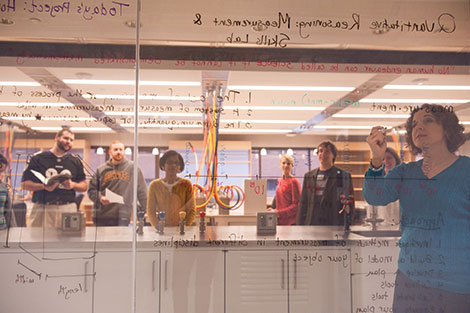 Measurement is the key to everything in science, technology, engineering and mathematics (STEM) fields. It’s also the key to demonstrating how these disciplines are tied together. But how can one make that point to a freshman STEM major?
Measurement is the key to everything in science, technology, engineering and mathematics (STEM) fields. It’s also the key to demonstrating how these disciplines are tied together. But how can one make that point to a freshman STEM major?
William LaCourse, the dean of UMBC’s College of Natural and Mathematical Sciences, has created a new interdisciplinary course for freshmen to illuminate just why measurement matters.
He is excited about the new offering: “This [class] goes right to the heart of what science is all about.”
Yet a course that seeks to explain measurement across disciplines requires a space that is adaptable, flexible and collaborative. Thus, the measurement class will be the first to be taught in UMBC’s newest space: the Collaboratory.
The Collaboratory is a joint venture between UMBC and the Howard Hughes Medical Institute (HHMI). UMBC provided the space and HHMI funded the $1.7 million build out. The space will be shared between the university (which will use it during the academic year) and the institute (which will use it in the summer).
The faculty who are involved in the creation and teaching of the new course are delighted by the possibilities offered by the Collaboratory.
“This space is pretty unique compared to other labs on campus set up to allow for different types of experiments that are not department specific,” says Tara Carpenter, a senior lecturer in chemistry. “The fact that the lab benches can be repositioned allows for a unique group dynamic, which is not something that can be done in other laboratories.”
Sarah Leupen, a senior lecturer in biological sciences, agrees. “You’re not limited by physical space to find the answer to the question you’re asking.”
The Collaboratory is designed so that almost every inch of it can be adapted to some sort of purpose in pedagogy or research. Even the walls.
“The ability to write on the walls is really cool,” observes Anne Spence, a professor of the practice in mechanical engineering.
– Nicole Ruediger
THE CYBER HIVE
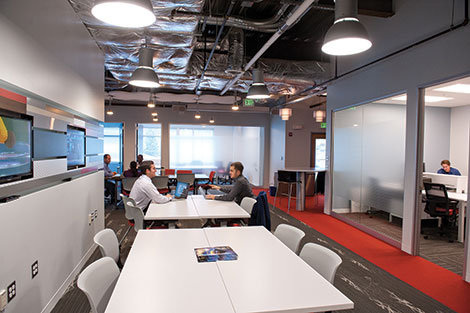 Proximity. Potentiality. Coffee.
Proximity. Potentiality. Coffee.
This morning, you can almost hear the first two qualities over the hiss of the coffeemaker as the employees of Integrata Security watch a presentation by their CEO, Mike Geppi in the CyberHive – a joint project between bwtech@UMBC, the Maryland Department of Business and Economic Development, Corporate Office Properties Trust (COPT) and Merritt Properties.
The Cyber Hive is a collaborative space with four tenants (including Integrata Security) and six affiliates. Tenants have dedicated office space and access to the common areas, while affiliates have access to the common areas. “It’s very high tech,” says Geppi.
Integrata Security is developing technology for secure wireless networks. The National Security Agency (NSA) was interested in how to make wireless networks secure, and after a survey of commercially available solutions, the agency determined that none was secure enough. So the NSA invented a new technology, which Integrata has licensed and is developing for commercial and government use.
For Geppi, part of the CyberHive’s allure is its location. “Being close to the NSA is fantastic,” he says. “Not only is the location of the CyberHive great but we also have access to the talent on the UMBC campus.”
Ellen Hemmerly, president and executive director of bwtech@UMBC, says that combination was just what she and her team had in mind with the venture, which will further boost the research park’s already burgeoning presence in the cybertechnology field.
“It adds to our cyber program at bwtech@UMBC by providing co-working space and meeting space that will facilitate the growing of our affiliate program, which houses cybersecurity companies that don’t need a dedicated office space,” she says “We also hope it will facilitate partnerships between cyber companies, UMBC faculty and students.”
Geppi says the design of the Cyber Hive makes it a naturally collaborative environment. “We do interact with other companies and that’s a real benefit. Having startups talk with each other. It typically leads to opportunity. We can develop strategic partnerships or find customers. Some of the entrepreneurs here are going through the exact same thing I’m going through and it’s good to be able to compare notes.”
While Geppi meets with his team, Tyler Simon and John Linford meet in a private office. They are both research scientists for Paratools, a software engineering firm. Simon, who is also a research scientist in the computer science and electrical engineering department at UMBC, agrees with Geppi about the Cyber Hive’s possibilities for collaboration.
“People are more likely to collaborate because they just walk by,” Simon observes. “It’s better than just a bunch of closed offices.”
Linford concurs: “It’s the first incubator I’ve been in that has that feature.”
– Nicole Ruediger
For more information about the Cyber Hive: http://www.bwtechumbc.com/pdf/cyberhive.pdf
Tags: Winter 2014

